If you’re tired of creating content that doesn’t rank or drive results, this SEO content strategy guide is for you. We’ll dive deep into what makes an effective content plan so you can create content that not only ranks well on search engines but also resonates with your target audience.
No more directionless content creation — you’ll have a clear framework to craft pieces that attract traffic, engage users, and advance your business goals.
Let’s explore how an intentional SEO content strategy connects search visibility with measurable growth.
Key takeaways
- Follow six core steps: define your audience, research keywords, create engaging content, optimize SEO elements, promote through the right channels and measure results to refresh regularly.
- Adapt to trends like AI-driven discovery, zero-click results and local visibility — not just vanity metrics.
- Tie SEO efforts to real business outcomes and reinforce credibility with E-E-A-T: expertise, authority, and trust backed by data, case studies, and accurate sourcing.
The importance of SEO content strategy: The 6-step framework
Before digging into each step, here’s a quick look at the full SEO content strategy framework that ties the process together.

An SEO content strategy is more than just publishing blog posts and hoping for clicks — it’s a structured framework that connects your audience, keywords and content to tangible results like traffic, engagement and conversions.
High-quality content is still the engine of SEO success, but it’s not enough on its own. Algorithms keep evolving, zero-click results are rising, and audiences expect content tailored to their needs. Without a clear plan, even great ideas can go unseen.
That’s where strategy comes in. By breaking SEO content down into repeatable steps — from defining your audience to refreshing old posts – you can build a process that consistently improves visibility and drives growth.
Let’s walk through the six steps of creating an effective SEO content strategy.
🎬 Learn what Slickplan can do!
We filmed a short video to show you exactly how to use Slickplan
1. Define your target audience
Knowing who you’re talking to is the most important step toward crafting a potent SEO and content strategy.
When you understand who your content is meant for, you can tailor it to their needs and preferences — driving more relevant traffic and engagement.
This starts with analyzing customer data and building marketing personas that represent your ideal customers. Together, these help you create content that resonates with your audience and supports stronger SEO performance.
Analyze customer data

Collecting and analyzing customer data provides actionable insights about your target audience.
By using tools like your CRM and Google Analytics (GA), you can uncover audience demographics and interests — helping you create SEO-friendly content that meets their needs.
Examining customer data reveals patterns and trends that highlight target audience preferences, search intent, and behavior.
That information can be used to:
- Refine your SEO and content strategy
- Generate new content ideas
- Research keywords with higher intent
- Create more relevant, useful content
- Meet audience needs
- Increase engagement and visibility
- Improve search rankings
- Drive more qualified traffic to your site
Popular tools include Google Analytics, HubSpot, Salesforce, Zendesk, and social media insights platforms.
Build marketing personas
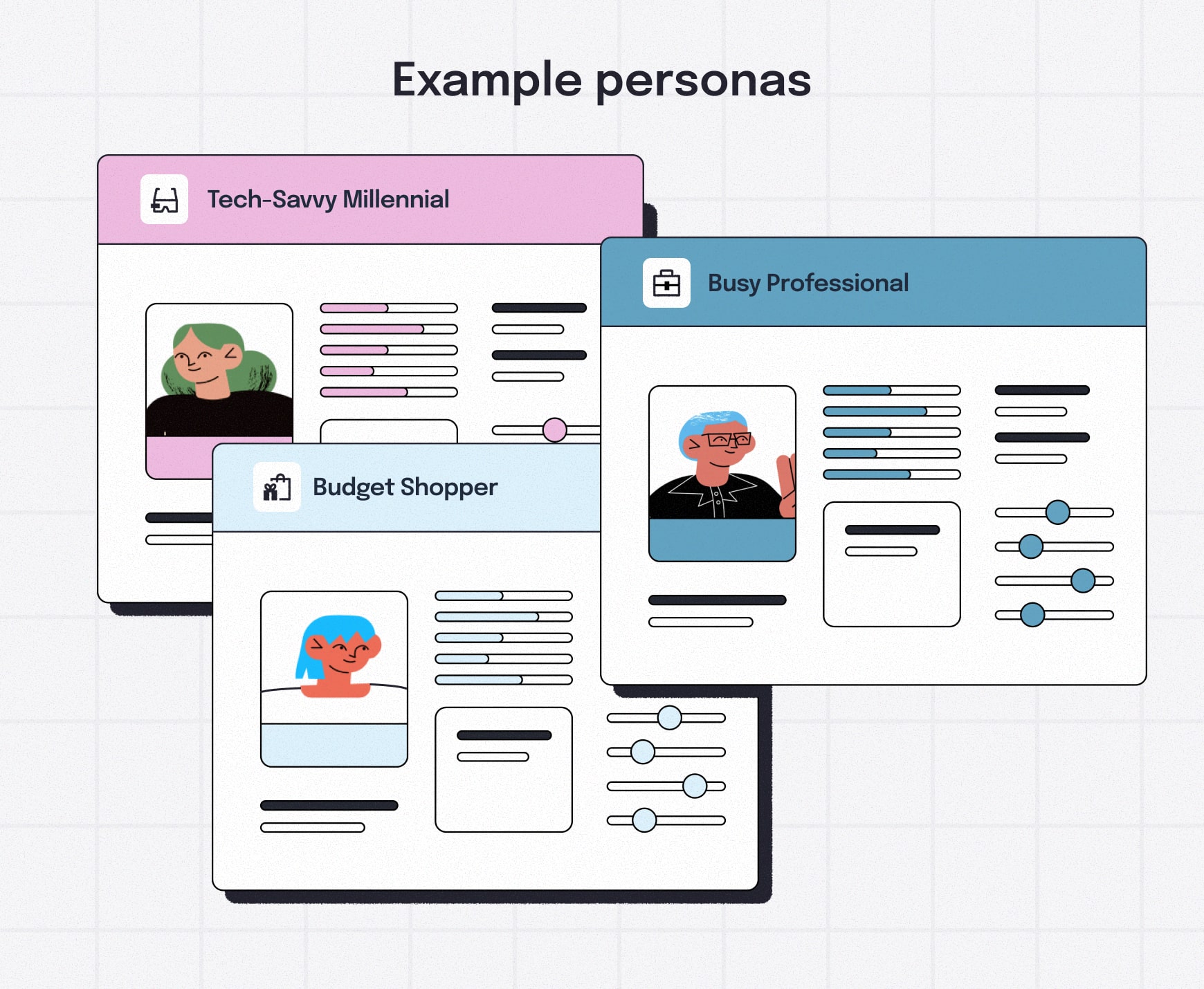
Marketing personas are fictional representations of your ideal customers that help you segment your audience for maximum effectiveness.
These personas can help you better understand your community and shape your content accordingly, resulting in a stronger content strategy for SEO.
Persona examples include "The Busy Professional," "The Budget-Conscious Shopper" and "The Tech-Savvy Millennial," but these should ultimately reflect your unique business and customers.
Developing and using marketing personas involves these steps:
- Research your audience using CRM tools, analytics, and social platforms
- Analyze data to create detailed profiles of your ideal customers
- Use these personas as the foundation of your SEO content strategy
- Create content that resonates with each segment and drives engagement and conversions
2. Do comprehensive keyword research
Identifying the right keywords helps you create content that ranks well and attracts the exact audience searching for what you offer.
How we search online — the keywords we use and how algorithms interpret them — revolves around intent. For example, "what is a goldfish" and "where to buy a goldfish" show completely different intentions, producing very different search results.
Thorough keyword research uncovers new opportunities and helps you build a focused list of terms that drive qualified traffic and conversions.
Keyword optimization remains one of the simplest yet most effective SEO tactics for boosting visibility and traffic.
Use keyword research tools
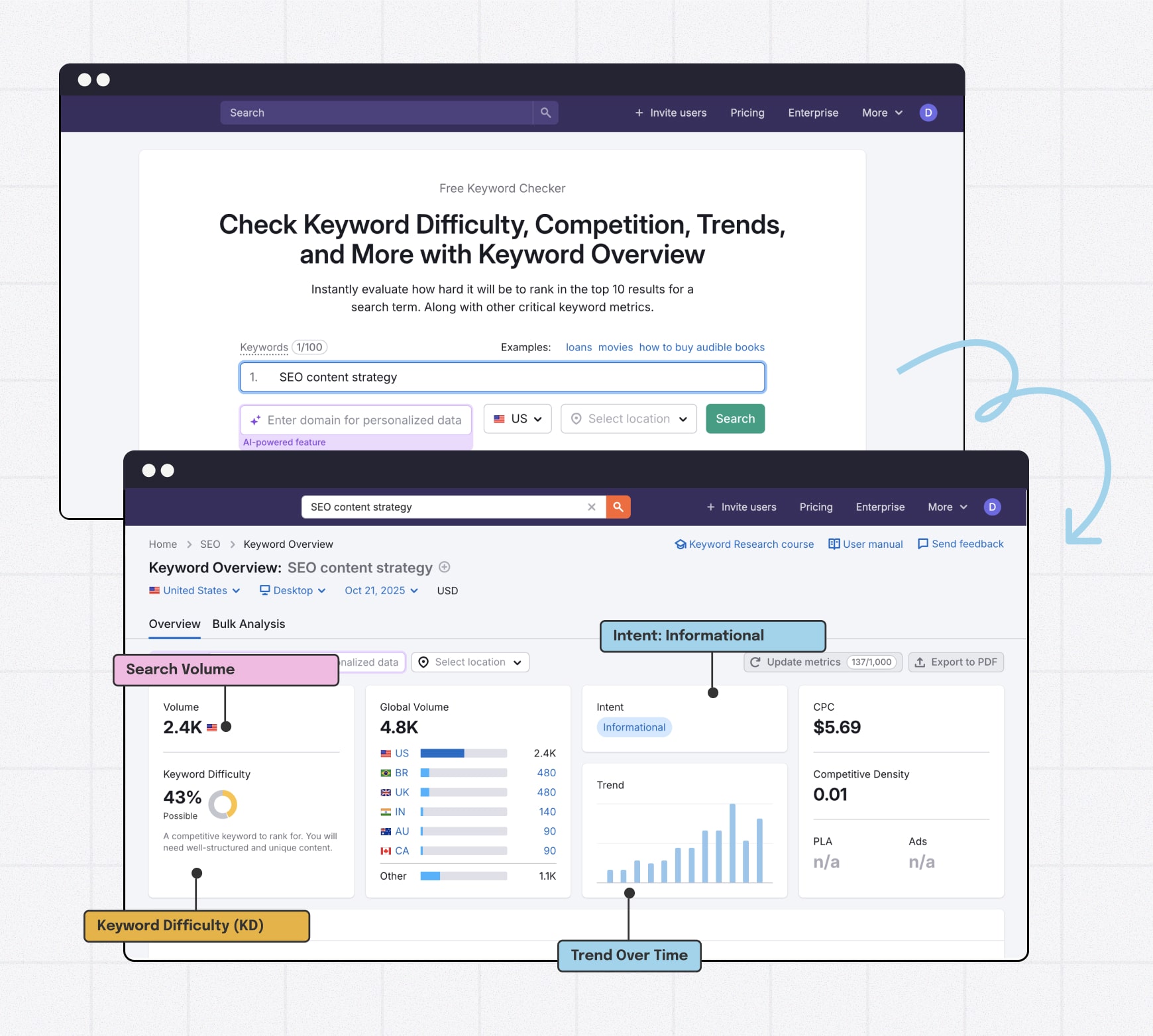
Tools like Semrush, Ahrefs, and Ubersuggest help you identify high-value target keywords, analyze competition and search volume, and track keyword rankings over time. They also provide keyword suggestions, difficulty scores, and trend data to help you make informed decisions about which terms to target.
These platforms are also great for uncovering related and long-tail keyword opportunities that reveal user intent.
Analyze keyword competition and search intent

Examining keyword competition and search intent helps you create content that aligns with what visitors actually need and improves your rankings in search results.
When you understand the competition and intent behind a specific keyword, you can:
- Create content that directly answers audience needs
- Improve your position in search results
- Align content with real search queries
- Optimize existing content for better performance
- Leverage long-tail keywords to capture niche intent
- Outperform competitors with stronger topic coverage
- Increase qualified website traffic
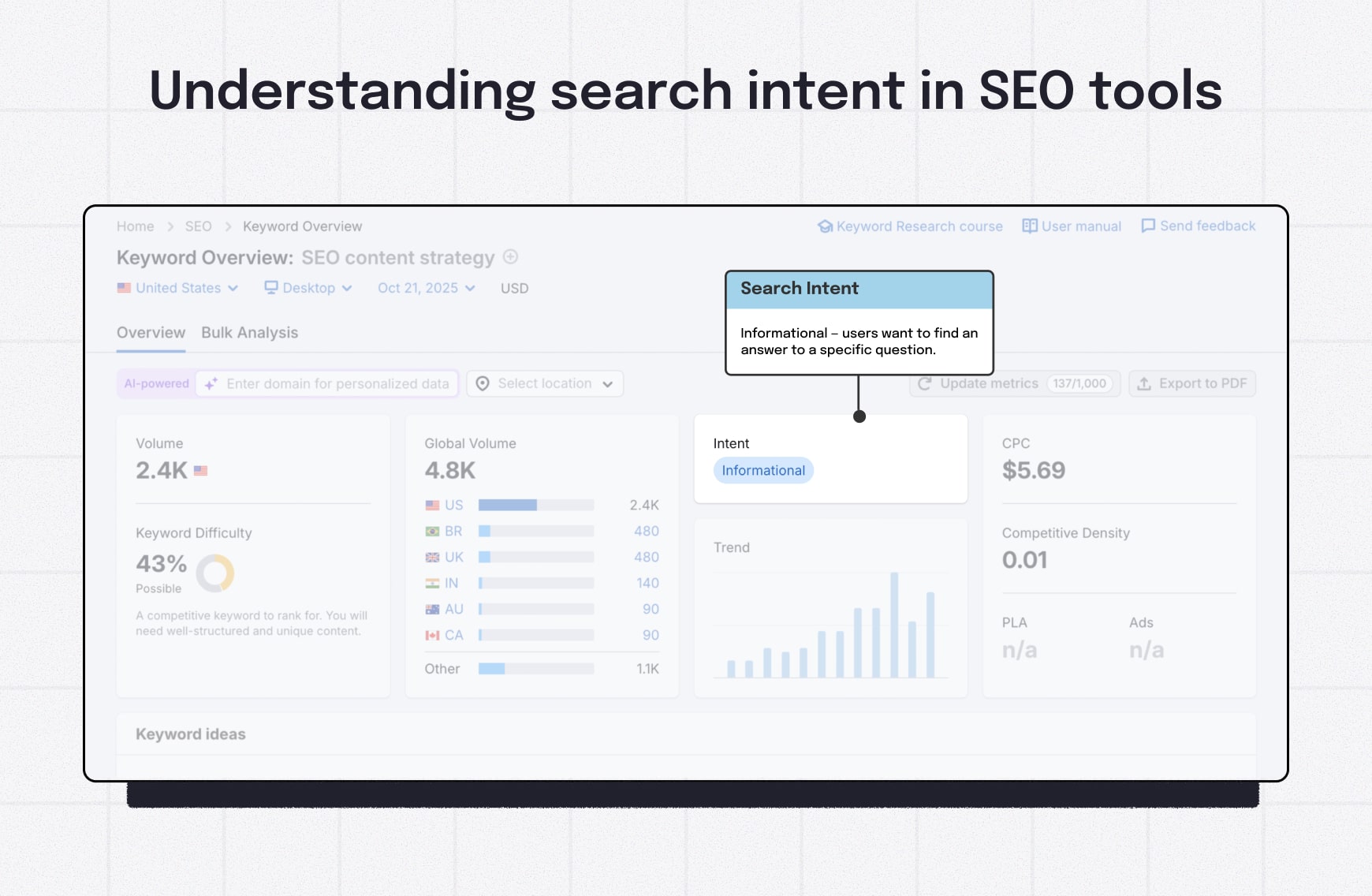
To analyze keyword competition use keyword tools to:
- Research both primary and long-tail keywords to see who’s currently ranking
- Look for patterns in top-performing content — note factors like length, structure, and domain authority
- Evaluate keyword difficulty scores with tools such as Semrush or Ahrefs
- Assess search intent — what problem is the user trying to solve?
After completing this analysis, you’ll know which keywords and topics to prioritize, how to meet user intent, and where to outperform competitors to capture more organic search traffic.
🚨Warning: Avoid keyword stuffing, search engines can detect it easily and may penalize your content.
3. Create engaging and varied types of content
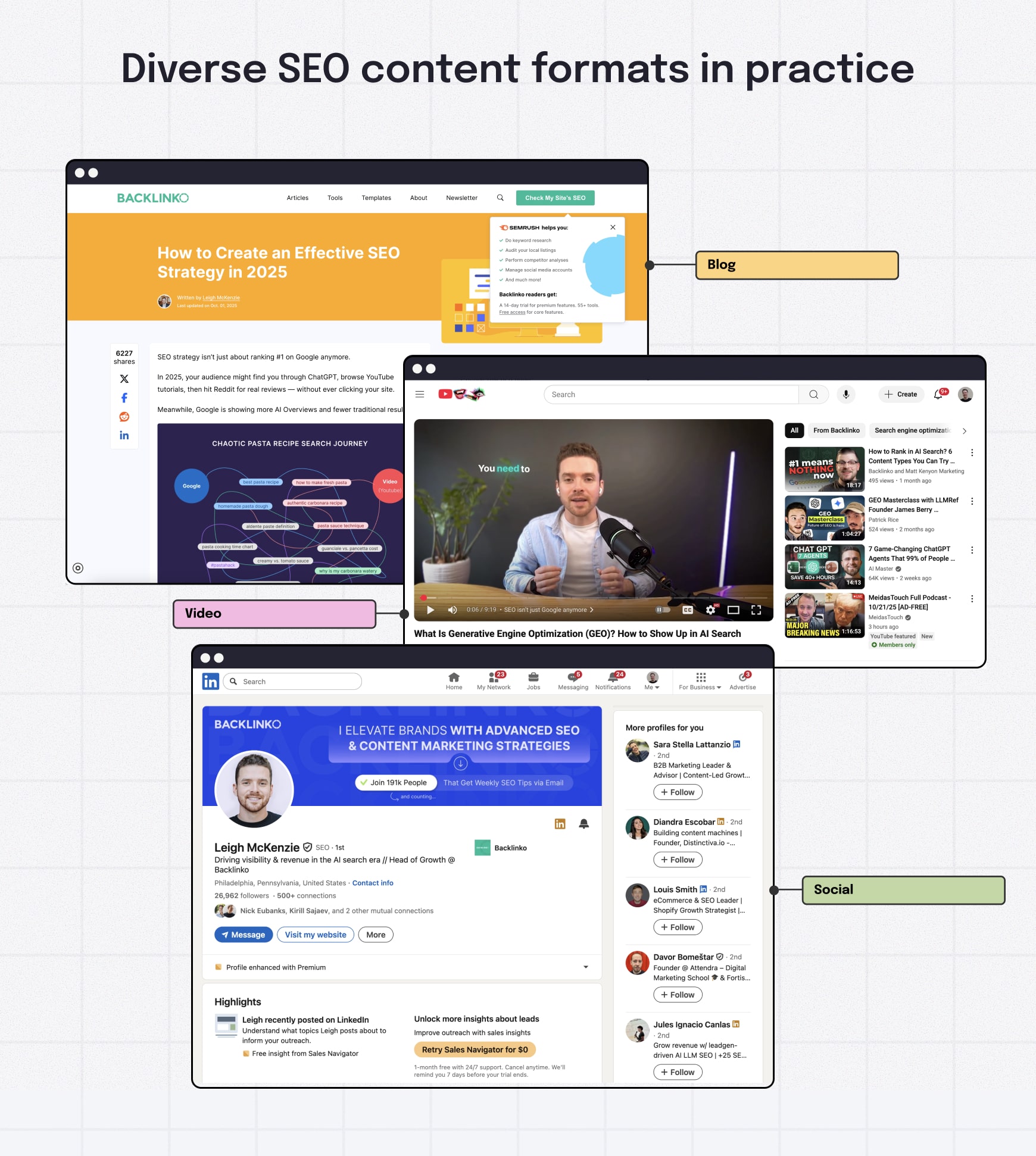
Variety is the spice of life and creating SEO content in different formats is key to maintaining audience engagement, sustaining interest, and boosting your overall SEO performance.
By creating a mix of content types — like blogs, case studies, and multimedia — you cater to different user preferences while keeping your content fresh and exciting. Here’s a short list to think about:
- Videos
- Podcasts
- Infographics
- Case studies
- White papers
- Success stories
- Short-form articles
- Social media content
- Long-form blog posts
- Webinars and online events
💡Slick Tip: The more types of SEO content you produce, the more important it is to understand SEO project management and to take advantage of tools like Slickplan and other GatherContent alternatives to make the job easier.
Blog posts and articles
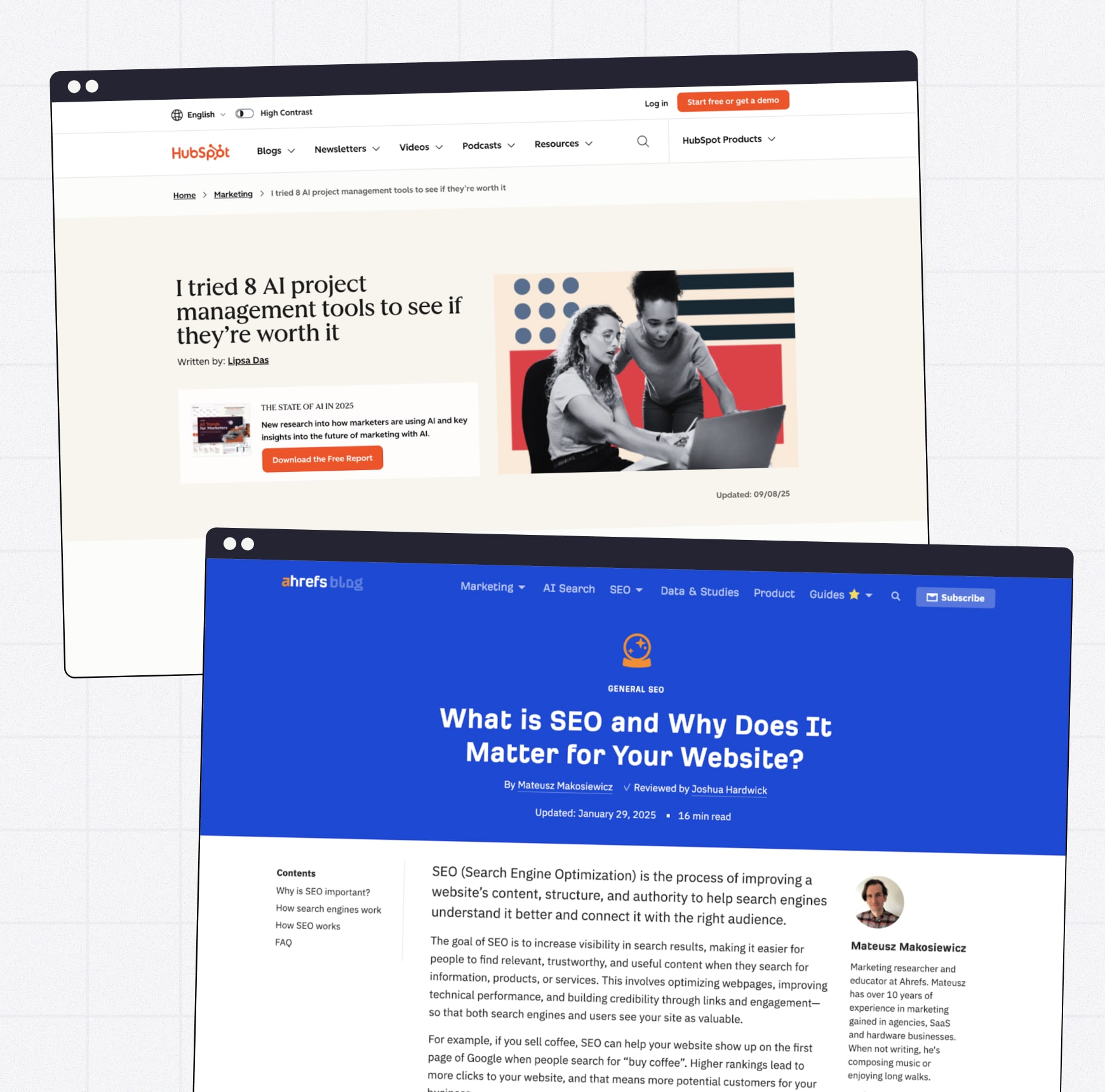
Blog posts and articles are the most common elements of most companies’ content strategy for SEO, providing valuable information to users and improving search engine visibility. They also sit at the core of SEO and content marketing, bridging keyword optimization with audience-focused storytelling.
That’s why blogs often make up the bulk of a company’s content inventory.
Creating high-quality content that ranks requires:
- Focus on developing relevant content for your intended audience
- Incorporate keywords strategically into each piece of content
- Optimize on-page SEO, off-page SEO, and technical SEO
Once your content is published, extend its reach by leveraging social media platforms, collaborating with influencers and industry experts, and using analytics tools to track and measure performance.
Multimedia content
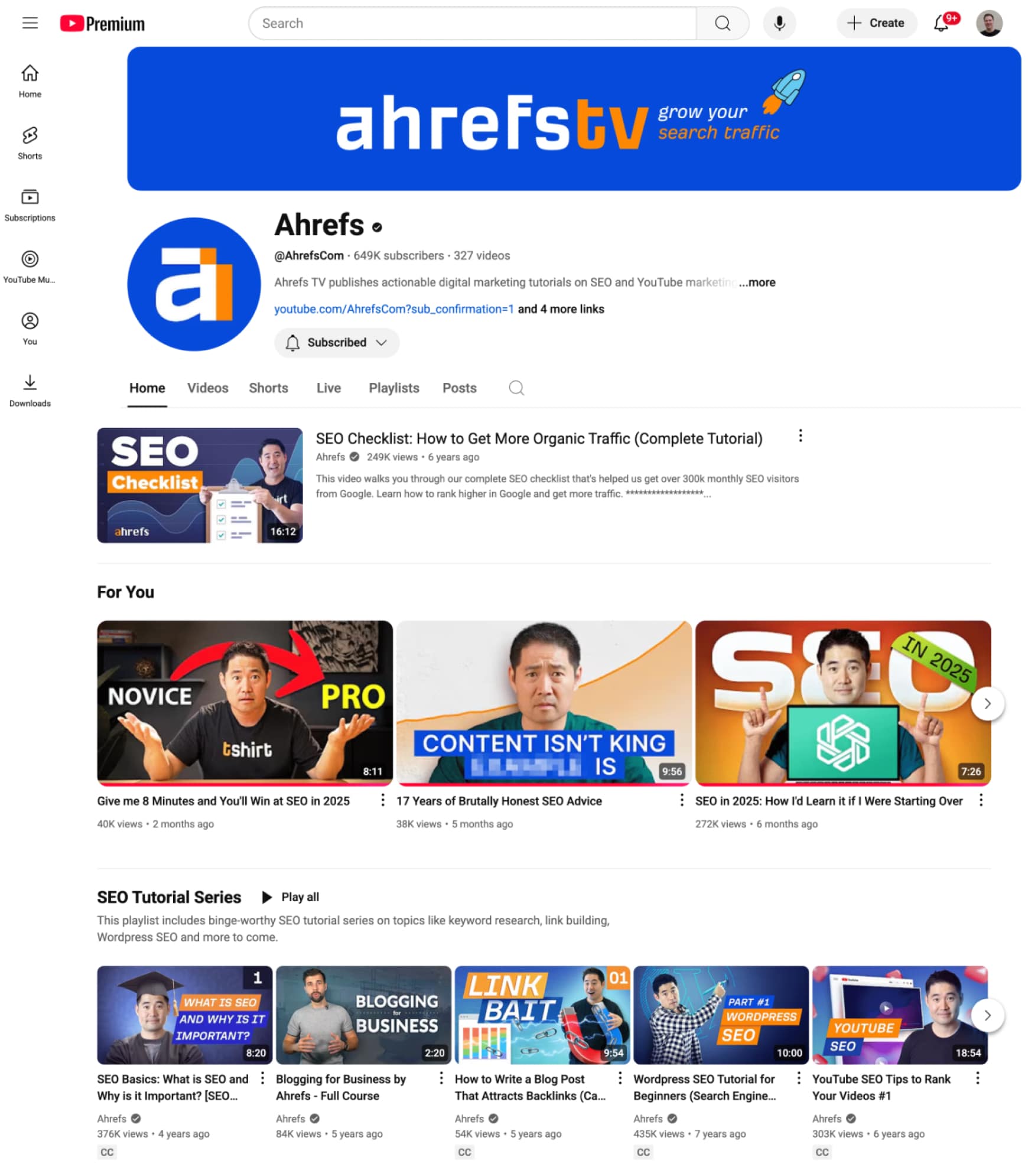
People are seeking content that can be quickly scanned, easily understood and shared. Creating visual and multimedia content alongside written material helps you cater to those preferences, diversify your content marketing touchpoints, and hold your audience’s attention for longer.
Multimedia content, like videos and infographics, provides engaging, easy-to-consume information that does exactly that.
Creating this type of content requires both technical and creative skills — from using video editing and design software to animation tools — or, as many companies do, outsourcing it to specialists.
For optimal performance, ensure every asset is optimized for search engines, mobile devices, and accessibility. That includes proper tagging, minimizing file size, and incorporating relevant keywords.
💡Slick Tip: All that content can feel overwhelming; put together a content calendar to keep track of everything you’ll be creating and when it’ll go out.
Related: How to become a content strategist
4. Optimize on-page SEO and technical SEO
By focusing on elements like title tags, meta descriptions, headings, internal and external linking, and core technical factors like crawlability and site speed, you can optimize content for both search engines and users. These tweaks may seem small, but an on-page content strategy should combine these fundamentals with technical SEO best practices to maximize visibility and engagement.
💡Slick Tip: Use an SEO content checker to see where you can make improvements to your SEO game.
Optimize title tags, meta descriptions and headings
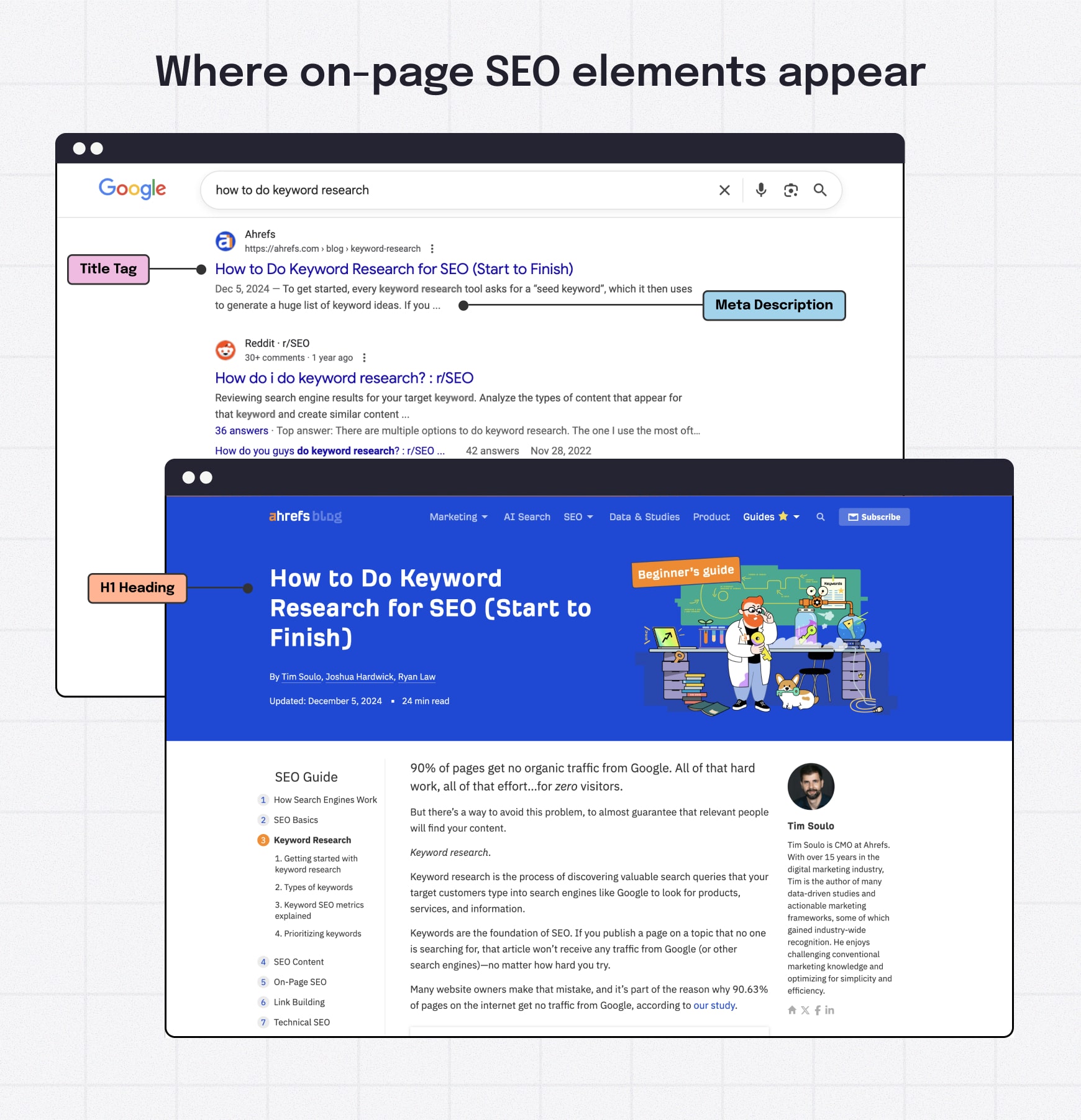
Title tags, meta descriptions, and headings form the core of on-page SEO best practices, helping search engines understand and index your content. When used thoughtfully with keywords, they also improve visibility and click-through rates.
This all stems from the keyword research discussed earlier and identifying which terms are most valuable for your specific content or project.
The idea is to then strategically incorporate these keywords into your page title, compelling meta description, tags, image alt text and headings to help search engines understand the content better and index it accordingly.
By focusing on these simple elements, you’ll be better positioned to achieve stronger results with your content and see more organic traffic.
Add internal and external linking
Internal and external linking play a major role in improving search engine optimization.
Internal links connect one page to another within the same domain — links within your own website.
External links, as the name suggests, are links to web pages on other websites or domains.
By providing additional resources and improving site structure , these links help users navigate your content more easily and find the information they need, which builds trust and keeps them engaged. Internal linking also improves crawl efficiency by creating clear pathways for search engines to discover, navigate, and index your pages.
Use these best practices when adding internal and external links:
- Use topic-specific keywords naturally in your anchor text
- Link to reputable, authoritative websites
- Mix
<dofollow>and<nofollow>links appropriately - Check regularly for broken links
- Avoid over-linking
- Ensure every link is relevant to your content
By following these link building strategies, you can enhance user experience, improve search visibility, and increase overall site traffic.
Don’t forget technical SEO
On-page elements only work when your site’s technical foundation is solid. Technical SEO ensures search engines can crawl and index your content effectively. Key factors include:
- Site speed: Even a one-second delay can hurt rankings and increase bounce rates
- Core Web Vitals: Meet Core Web Vitals thresholds to improve UX and eligibility for top placements
- Mobile optimization: With mobile-first indexing, a responsive design is non-negotiable
- Secure connections (HTTPS): SSL certificates are a baseline trust signal
- Crawlability: Use a clean robots.txt, XML sitemap and logical URL structure so crawlers can map your site
- Structured data: Schema markup helps search engines understand your content and improves eligibility for rich results
Without this technical layer, even the best titles, keywords, and content may struggle to rank.
5. Distribute, promote and build off-page SEO
Distributing and promoting your content is what takes it beyond your website and gets it in front of a wider audience.
If you don’t promote your own content, who will?
Promotion is often the missing piece in most SEO strategies. Being proactive about sharing your work — through social media, influencers, and industry collaborations — helps amplify reach and attract high-quality backlinks.
By using multiple channels to get your content seen, you’ll strengthen your off-page SEO, build authority, and maximize the overall impact of your content strategy and your SEO plan.
Tap into social media platforms

Love them or hate them, platforms like Instagram, LinkedIn, X, and others are often the go-to channels for growing content visibility and attracting more readers or viewers.
Social activity doesn’t directly drive rankings, but it extends reach and can spark the backlinks and mentions that fuel off-page SEO.
Follow these steps to make the most of social media for SEO and audience growth:
- Create content that’s captivating and relevant to your audience
- Optimize each post for its platform using appropriate keywords and tags
- Use relevant hashtags to increase discoverability
- Post consistently to maintain an active presence
- Engage with your audience by responding to comments and questions
- Collaborate with influencers and industry experts to expand your reach
Collaborate with influencers and industry experts

Another way to improve authority and trust is by partnering with influencers and industry experts, using their reputation to strengthen your own.
Collaboration offers several key benefits for your content:
- Drives new audiences to your content
- Creates backlinks to your website
- Builds credibility and brand authority
- Enhances overall SEO performance
- Expands your content’s reach
- Boosts user engagement
- Improves search rankings

To find and collaborate with influencers and industry experts, try this:
- Research potential partners and build a contact list
- Reach out with a clear, personalized collaboration proposal
- Negotiate terms that are mutually beneficial and align with your content goals
Beyond the expanded reach, remember that partnerships build credibility and generate authoritative backlinks — still one of the strongest off-page SEO signals.
6. Measure results and refresh your SEO content strategy
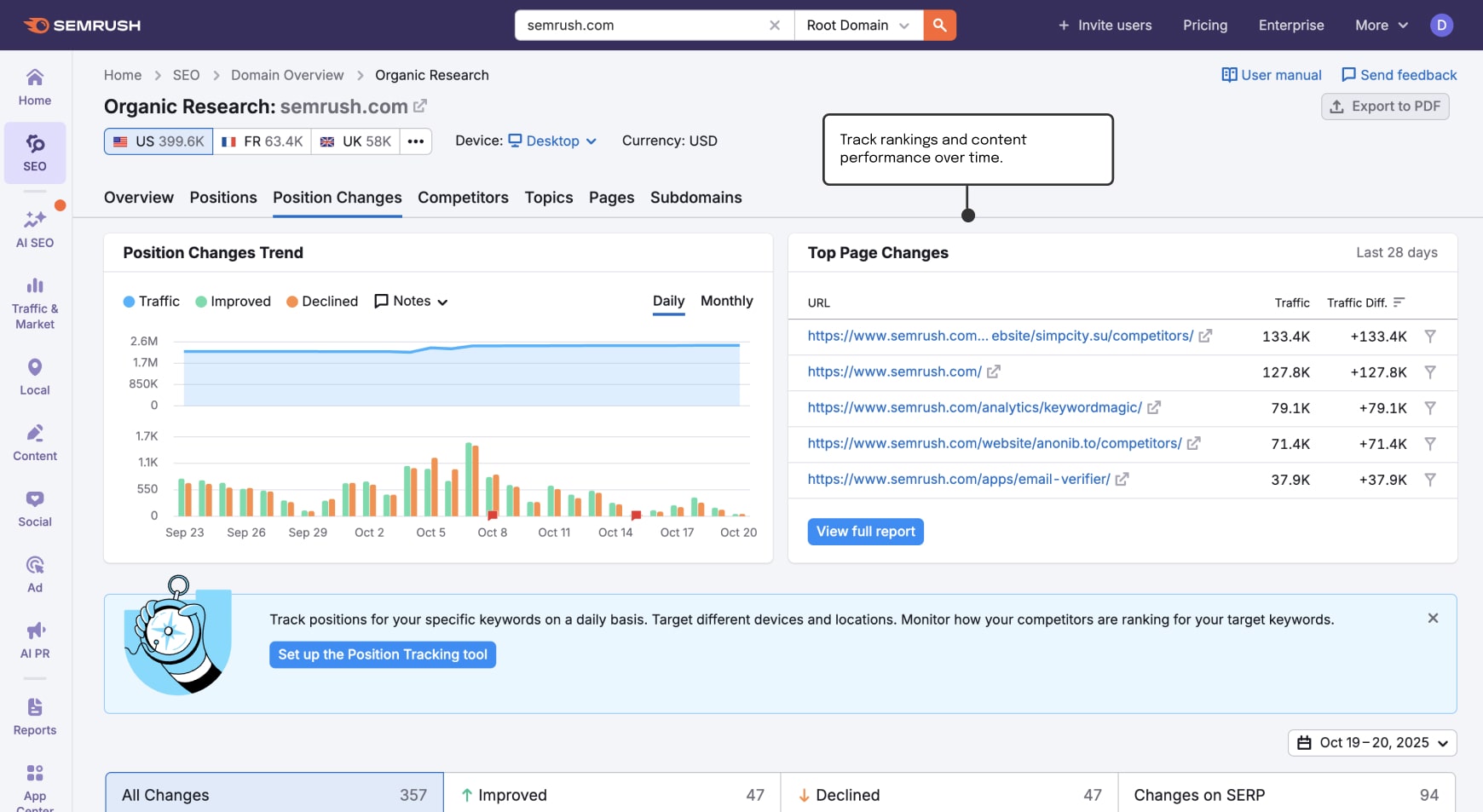
How do you know if your SEO content plan is working?
By tracking and analyzing content performance to pinpoint areas for improvement.
Monitoring metrics like organic traffic, sessions, and conversions — alongside engagement metrics such as bounce rate and time on page — helps you gauge how effective your content really is and identify what’s working (and what isn’t).
This kind of analysis allows you to make targeted updates and optimizations that keep your content resonating with your audience and driving results.
Use analytics tools
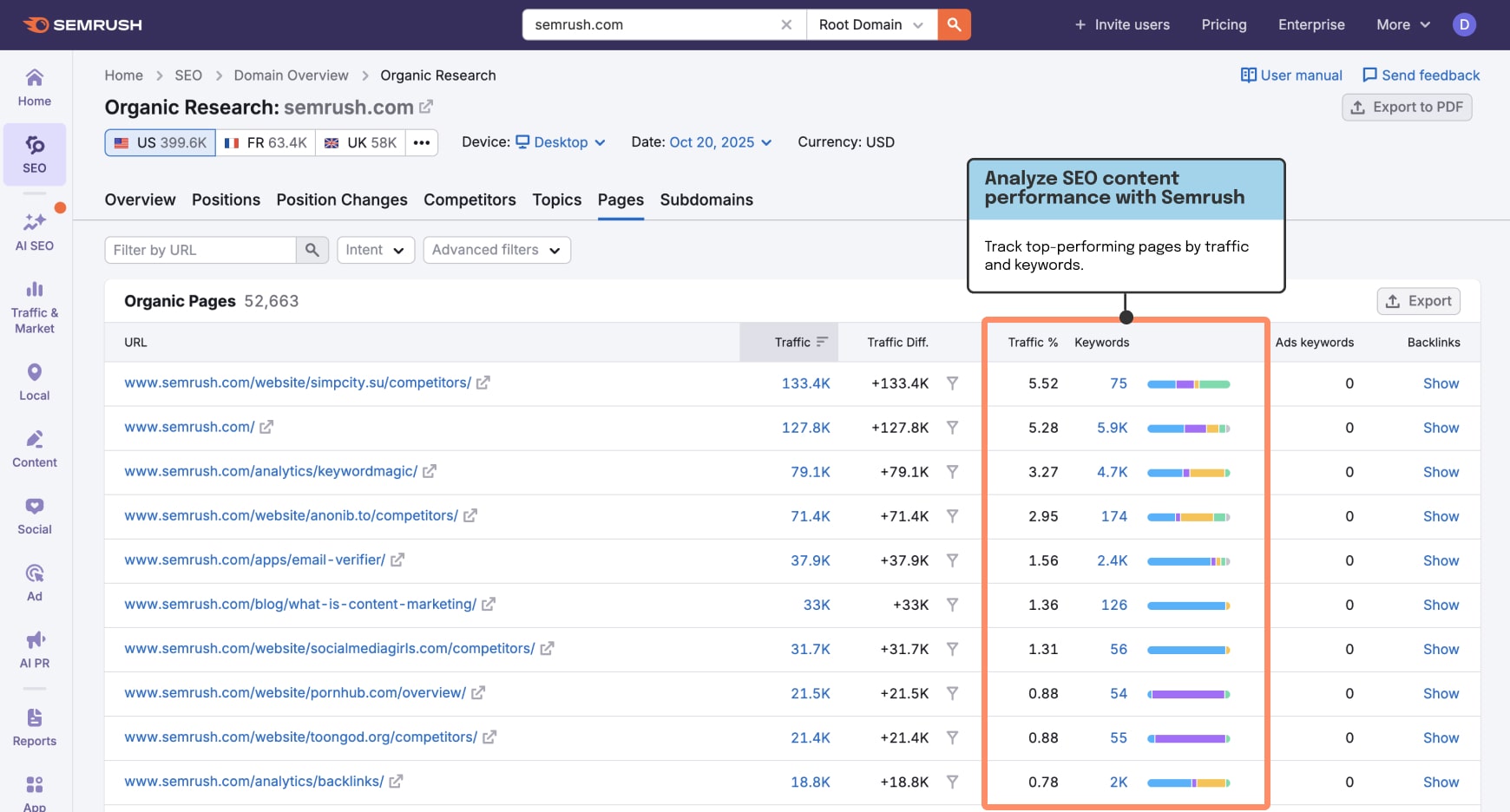
The more SEO data you have, the better results you can achieve with your content.
Track the right key performance indicators (KPIs)
Start by aligning metrics with your business goals:
- Traffic KPIs: organic sessions, impressions, click-through rates
- Engagement KPIs: bounce rate, time on page, pages per session
- Conversion KPIs: leads generated, sales, downloads or sign-ups attributed to organic search
- Visibility KPIs: keyword rankings, share of voice, featured snippet wins
Monitoring these key performance indicators shows not just what’s happening, but whether your SEO efforts are driving the outcomes you actually care about.
SEO tools like Google Analytics, Google Search Console, Semrush and Ahrefs are a great place to start, helping you make the data-driven decisions that improve content performance.
Regularly update and optimize content

Regular updates and optimization of your content ensures it stays relevant, valuable and engaging, enhancing user experience and raising your search rankings.
Use analytics tools to identify pages that are losing traffic or rankings, then refresh them to keep your site up to date and competitive.
Refresh your content with:
- New information
- Restructured content
- Current stats and data
- Fresh visuals or videos
Given the shifting nature of search, it’s important to revamp your SEO too. Incorporate relevant keywords, optimize title tags, meta descriptions and headings, and add internal and external linking.
Emerging SEO trends
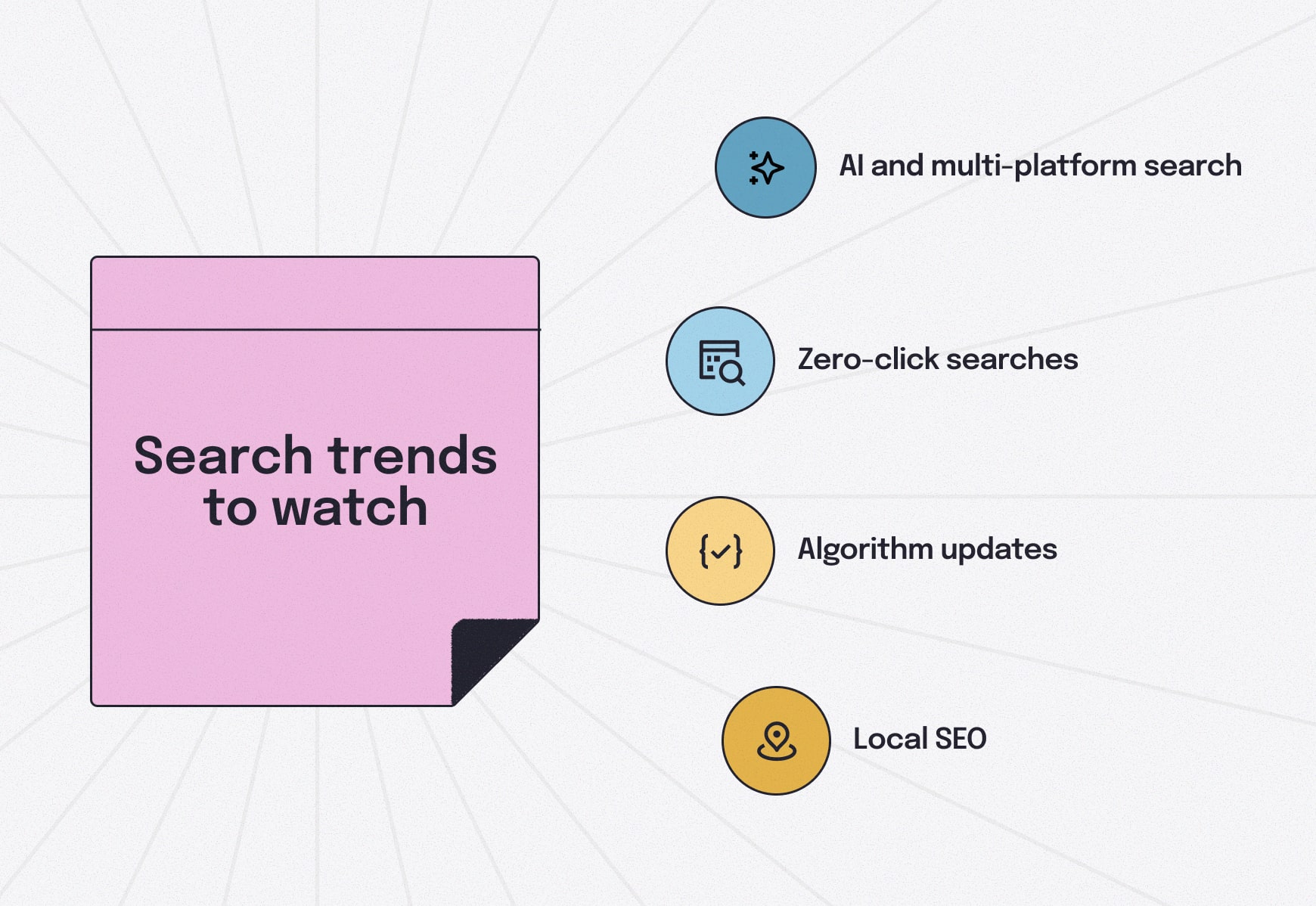
Search engine algorithms never stand still, and in 2026 the changes go beyond core updates. The latest SEO trends, like AI-driven summaries, zero-click results and multi-platform discovery have reshaped how people find information — and how marketers need to think about visibility.
AI and multi-platform search
Searchers don’t always start on Google anymore. People might ask ChatGPT, watch a YouTube explainer or scroll Reddit threads before ever clicking a link. That means keyword research and SEO content planning should look across multiple platforms, not just search engines.
Zero-click searches

As you can see above, because the AI overview provides enough information, there’s not much of a need to click any of the search results. Nearly 60% of Google searches end without a click (other studies show numbers closer to 30%; either way though, a sizable amount of searches end without a click).
Featured snippets, People Also Ask boxes and AI Overviews are all providing answers directly on the search engine results page (SERP). To capture that visibility, you need to structure your content to answer common questions concisely, use clear subheads and include schema markup so search engines can surface your content in these places.
Adapting to algorithm updates
The search landscape is ever-changing and as with everything else in life, the principle stays the same: adapt or get left behind. Each update can shift how search engine rankings are calculated, making it essential to review performance data and adjust.
Updating content regularly, keeping technical SEO solid and following search quality guidelines will keep your content relevant even as algorithms evolve.
Local SEO

For businesses with a local presence, local SEO remains critical. Optimizing Google Business Profiles, earning positive reviews and creating location-specific content will all help you appear in "near me" searches.
With mobile-first behavior and map results dominating local SERPs, visibility here can drive real-world traffic as much as digital clicks.
Tie SEO content strategies to business outcomes and E-E-A-T
and content strategy should directly support business outcomes, whether that’s more leads, higher revenue or stronger brand visibility — all of which are strengthened by the relationship between SEO and content marketing.
Link content strategy for SEO to business goals
As you track organic traffic, engagement and conversions (see Step 6), make sure those numbers are leading toward your bigger objectives. For example:
- More organic sessions should translate into pipeline growth
- Engagement improvements should align with nurturing buyers through the funnel
- Keyword visibility should strengthen overall brand authority in your market or industry
Framing metrics this way ensures SEO isn’t just about moving up the SERPs; it’s about delivering measurable business impact.
Build trust with E-E-A-T
Back in December 2022, Google shifted its search rater guidelines from E-A-T (Expertise, Authoritativeness and Trustworthiness), to E-E-A-T; the additional "E" for Experience.
- Experience: real-world case studies, results and examples
- Expertise: content authored or reviewed by knowledgeable professionals
- Authoritativeness: external citations and backlinks from trusted sources
- Trustworthiness: accuracy, transparency and clear sourcing
Demonstrating E-E-A-T makes your content more credible to both users and search engines. Simple steps like adding author bios, citing reliable data and publishing original insights can strengthen your authority and help your content weather algorithm updates.
Build an effective content and SEO strategy for 2026 that delivers
Strong content planning goes hand in hand with an effective SEO strategy. By defining your audience, researching the right keywords, creating engaging content, optimizing on-page elements, promoting through the right channels and continually measuring results, you set the foundation for sustainable growth.
Now is the time to put these insights into action for next year using Slickplan’s Content Planner — a collaborative space where your team can plan, organize and deliver content (and SEO optimization) that works.
Follow these steps and use the right content planning tools to create an SEO content strategy that not only ranks well but also resonates with your audience, drives consistent traffic and converts.
Plan smarter content with Slickplan
A collaborative workspace to handle all your content needs. Plan, gather and create together.
Frequently asked questions
What is SEO content strategy?
An SEO content strategy is a structured plan for creating, optimizing and promoting content so it ranks in search engines and meets audience needs. It combines keyword research, topic planning, on-page optimization and ongoing updates to attract traffic and achieve business goals.
What is an SEO content strategist?
An SEO content strategist is someone who plans, creates and optimizes content to improve search visibility and meet company goals. They combine keyword research, audience insights and SEO best practices to craft content plans that attract organic traffic, boost engagement and drive measurable results.
How do I create a content plan for SEO?
To create a content plan for SEO, define your audience, research relevant keywords and map them into topic clusters. Build a calendar of content types, optimize each piece for on-page SEO, promote through channels like social and email, then track performance to refresh content over time.
What are the 4 pillars of SEO?
The four pillars of SEO are technical SEO, on-page SEO, off-page SEO, and content. Technical SEO ensures your site can be crawled and indexed properly. On-page SEO focuses on optimizing titles, meta descriptions, and content. Off-page SEO builds authority through backlinks and brand mentions. Finally, content involves creating valuable, search-aligned material that meets user intent.
How to do content SEO?
Content SEO means optimizing written and multimedia content for search engines and users. Start with keyword research, then create high-quality content around those terms. Use headings, internal links and metadata to signal relevance. Finally, refresh old posts with up-to-date stats and insights to maintain rankings.
What are the 4 steps of content strategy?
While frameworks can vary, most SEO content strategies follow four key steps: research, plan, create, and measure. Research involves defining your audience and goals. Planning includes mapping out topics, content formats, and a publishing calendar. The creation phase focuses on producing content optimized for SEO, and finally, measuring means tracking results, updating content, and adjusting the overall strategy to improve performance.






 X
X

